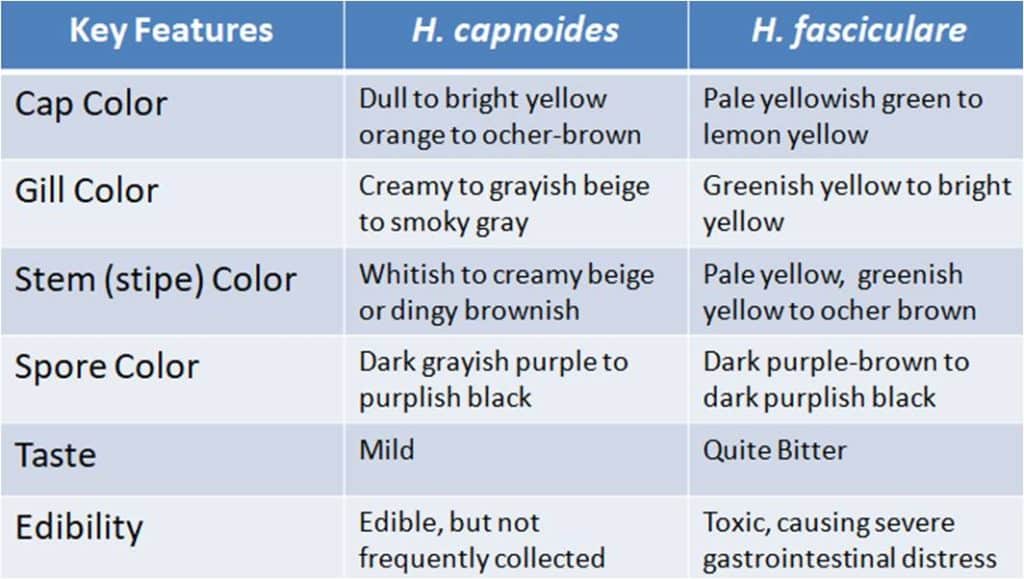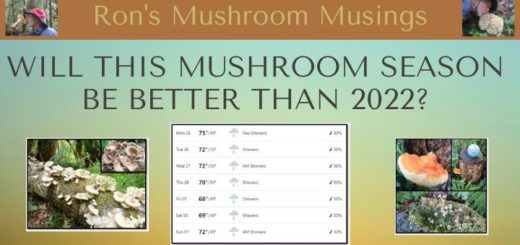Truth or Dare

Some of you may remember actually playing “truth or dare” at some time in your life along with other classic teenage party games like “spin the bottle”, or “seven minutes in heaven”. However, my reference to truth or dare isn’t about a teenage party game, rather it relates to a specific genus of mushrooms known as Hypholoma. The two specific mushrooms of interest in this genus are H. fasciculare and H. capnoides. I will tell you the truth about these two quite similar mushrooms and you will have to decide afterwards if you feel comfortable enough to dare and eat one of them.
Both of these species are found along our pacific coastal states and eastern states with cooler winter weather. Both are Saprotrophic species that digest the cellulose of dead conifer trees and/or their buried or exposed roots. At first glance it can be difficult to tell these two related species apart so it is necessary to give them a very detailed going over. Especially since one of them, H. fasciculare is toxic while H. capnoides is considered to be edible.

H. fasciculare is the mushroom we find most often and when in fruit it can totally cover whatever it’s decomposing. It’s common name “Sulfur Tuft” relates to the mushroom’s sulfur like gill color, at least when it’s young. We typically find it in very dense clusters directly on dead wood; however, it can also be found in the duff where it is decomposing tree roots or some other buried piece of wood. Remembering that this is the toxic of the two species is quite easy since imbedded in its species name are the letters scic, which is pronounced just like the word sick. While that’s all well and good, the tricky part is in associating the right name with the right mushroom.

Much like its toxic cousin, H. capnoides is also a decomposer and can be found eating away at the same types of dead conifer trees in the same locations. I’d like to say that naturally occurring bar codes make deciphering who is who and which is which quite easy but unfortunately you’ll need your keen Sherlock Holmes powers of perception to separate these two characters. Not to give anything away but the most important feature differentiating these two mushrooms is gill color. Keep in mind that optimum gill color needed for identification is associated with younger specimens as gills of older mushrooms will be impacted simply by age and spore dispersal. Another telling factor will be taste as H. fasciculare is bitter tasting while H. capnoides has a mild flavor. And let me emphasize that tasting and spitting out a small piece of mushroom cap will not make you sick as you actually need to swallow and digest a mushroom to gain all the benefits of enjoying gastrointestinal distress.
To make it easier, I have put together a little matrix for these two mushrooms showing some of their color characteristics. The data was taken from the book “Mushrooms of the Redwood Coast”, by Noah Siegel & Christian Schwarz.

In General, the primary take away from this matrix is in fact the gill color differences and to help me remember which is toxic and which is not I memorized the very clever little phrase; gray is OK, yellow unlucky fellow. If you are still somewhat hesitant about even bothering with this mushroom I do not blame you in the least as I have yet to try H. capnoides myself. Instead I have taken an easier and may I say much safer approach.

To save myself from the possibility of experiencing gastro-stress I purchased a spawn block of a really cool mushroom in the same genus called Hypholoma lateritium or more commonly called the Brick Cap mushroom, due to its reddish cap color. While it seems to have quite the collection of other common names I believe Brick Cap is quite appropriate. Not only is this an attractive mushroom but it was amazingly easy to find since it grew in a large plant pot right in our backyard. I ordered the spawn block from Field & Forest located in Peshtigo, WI. I simply filled a planting pot half full of hardwood chips and sawdust, broke up the spawn block into several chunks, put them into the pot an filled the rest of the pot with the same wood material. I did this during the summer and it started fruiting in mid November, after the temperatures dropped. Unfortunately, the Brick Cap mushroom or Hypholoma lateritium is mostly native to the eastern third of North America where hardwood trees are numerous and winters get cool enough to encourage them to fruit.

It is super easy to cultivate as I mostly neglected the planting pot the entire time it was in our yard and there is no guesswork as to who it is. The flavor is good and somewhat nutty and I consider it a “Green” produce product as our car never left the garage so zero fossil fuel was needed in locating it. Except for cap color, it has the classic Hypholoma gill configuration and spore print as its two Western cousins.
So, if you’re like me and have no interest in playing the mushroom version of Truth or Dare, give the Brick Cap mushroom a try and avoid all the guesswork.
Happy mushroom hunting and do give backyard cultivation a try. You’ll love it….
Ron
References;
Teenage Games at wikipedia
Description of Hypholoma capnoides at MushroomExpert.com
Description of Hypholoma fasciculara at Mushroom Expert
Brick Cap mushroom at Wikipedia
Spawn and mushroom supplies at Field and Forest





